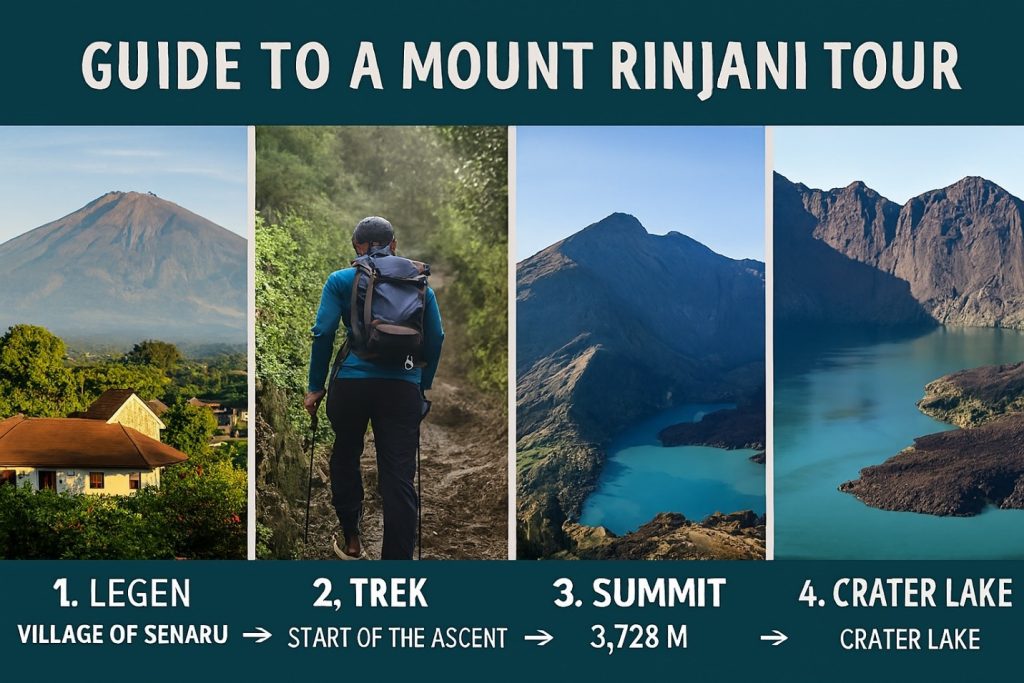Mount Rinjani, standing proudly at 3,726 meters, is not just the second-highest volcano in Indonesia; it’s a monumental natural spectacle and an unforgettable adventure. Located on the island of Lombok, a Mount Rinjani Tour is a must-do for outdoor enthusiasts, offering a challenging yet rewarding Mount Rinjani Trekking experience with views that defy imagination.
The mountain’s centerpiece is the stunning crescent-shaped Segara Anak crater lake, an active marvel nestled 600 meters below the rim, complete with a new, smaller volcanic cone, Mount Baru Jari, rising from its waters. A journey here is more than a hike; it’s a spiritual and physical challenge that immerses you in the raw beauty of the tropics.
Planning Your Mount Rinjani Trekking Adventure
Trekking Rinjani is an experience that requires preparation. It’s a demanding climb, featuring steep inclines, rocky trails, and the final, grueling push to the summit through loose volcanic sand. However, with the right preparation and the mandatory guidance of a licensed tour operator, this challenge becomes a triumphant memory.
The Best Time to Go
The ideal period for your Mount Rinjani Tour is during the dry season, from April to November. During this time, the weather is more stable, and the trails are safer. The national park is typically closed from January to March due to heavy rain and the increased risk of mudslides and landslides, so plan accordingly.
Mandatory Guides and Permits
It is compulsory to hire a licensed guide and porters and obtain a permit from the Rinjani National Park office for all treks. This system ensures your safety, provides employment for local communities, and contributes to the park’s conservation efforts. Reputable tour packages will include the permit fee, guide, porters, camping equipment, and meals.
Choosing Your Rinjani Trekking Route
Mount Rinjani offers several routes, but three are the most popular, each providing a distinct experience:
The Sembalun Route: The Path to the Summit
The Sembalun route is the most direct way to the Rinjani summit.
- Best for: Trekkers determined to reach the 3,726m peak.
- Scenery: Begins across vast, open savannah, offering sweeping views of the eastern side of the mountain.
- Itinerary: Most trekkers choose a 3-day/2-night trek from Sembalun to the Summit, then down to the Segara Anak Lake, before finishing in Senaru. A shorter, challenging 2-day/1-night option focuses only on the summit and is best for experienced climbers.
- The Challenge: The final ascent to the summit is notorious—a 1,000-meter climb over loose volcanic scree, where every two steps forward feels like one step back!
The Senaru Route: Crater Rim Views and Lush Forests
The Senaru route is generally considered easier for those who don’t aim for the main summit but still want a spectacular Rinjani experience.
- Best for: Beginners, nature lovers, and those prioritizing the crater lake view over the summit.
- Scenery: Winds through dense tropical rainforest on the lower slopes, a fantastic opportunity to spot local wildlife like the black monkeys (lutung).
- Itinerary: The popular 2-day/1-night trek takes you to the stunning Senaru Crater Rim (2,641m), providing a breathtaking panoramic view of Segara Anak Lake and the summit, before descending back to Senaru. This is often called the “Second Summit” experience.
The Torean Route: The Scenic River Valley Exit
This route has gained popularity as a scenic alternative or a descent option.
- Best for: Trekkers seeking a less crowded, varied trek with beautiful river and waterfall views.
- Scenery: Features lush valleys, river crossings, and direct access to the Segara Anak Lake and its therapeutic hot springs.
- Itinerary: Often used as the final descent on a 3-day or 4-day traverse (Sembalun-Summit-Lake-Torean), making for a visually diverse journey.
Essential Tips for a Rewarding Tour
To make your Mount Rinjani Trekking a success, keep these tips in mind:
- Trek with an Operator: Booking a package is essential and the safest way. Prices typically range from $150 to $300 USD per person for a shared 2-4 day trek, depending on the service level. This usually includes all essentials: guide, porters, food, equipment (tent, sleeping bag, mattress), park fees, and transport.
- Be Physically Ready: Rinjani is strenuous. Incorporate cardio and leg strength training into your routine before your trip.
- Pack Smart: While porters carry the main equipment, you will carry a daypack. You need warm, windproof layers (especially for the freezing summit attempt), good quality hiking boots with ankle support, a headlamp, sun protection, and a basic first-aid kit.
- Stay Hydrated: Reputable guides will ensure you have enough water, but bring a refillable bottle and electrolytes.
- Bring Cash for Tipping: Your guides and porters work incredibly hard, often carrying heavy loads using only bamboo poles. Tipping is customary and well-deserved—a minimum of IDR 100,000 per porter/guide from each person is a good guideline.
- Practice ‘Leave No Trace’: Rinjani is a National Park. Ensure all your trash is carried out. Many eco-conscious tour companies run “Green Treks” with a focus on environmental sustainability.
A Mount Rinjani Tour is a true highlight of any trip to Indonesia. It demands respect, fitness, and determination, but the reward—standing above the clouds at the crater rim, soaking in the Segara Anak hot springs, or witnessing a fiery sunrise from the summit—is a profound experience that will stay with you long after you’ve descended.

